All-round Puppy Health Care
Puppy health care is a lifestyle. It consist of anything from her diet to mental well-being and everything else in-between! The by-product? It benefits not just your new canine but for you too! You see, playing and walking your dog keeps both of you fit. Likewise, being conscious about what you feed her would likely make you think twice about what you put in yourself (and family) too! What about mental well-being? Studies have shown that positive interactions with your dog helps curd depression.
These are but just some examples of how fussing over your puppy health care would have a pronounced impact on your quality of life. It is therefore not a stretch to see the connection that a happy, healthy dog would likewise have a happy, healthy parent!
The truth is, young puppies require as much supervision and care as human toddlers. That means someone being at home most of the time especially during her first week or two to feed, exercise, toilet train, socialize her, etc. It might seems a lot to take in at first but most of these make sense and once they become a part of your life (habits), it will become second-nature. Now let's break it down shall we.
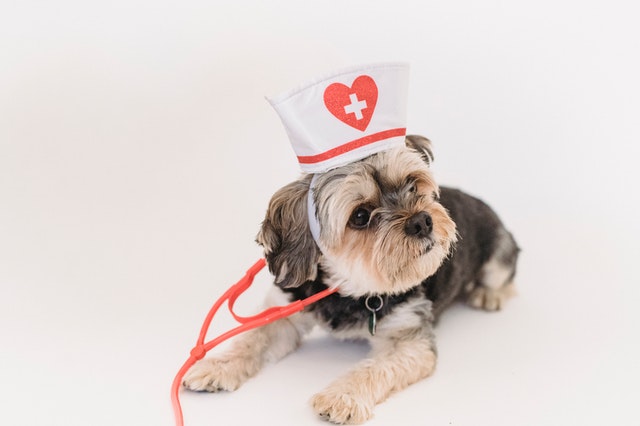
As this is a long page, use the links below to jump to your topic of interest.
- Diet and weight control
- Grooming with other puppy health care routine
- Yearly puppy health care checkups
- Taking up a veterinary insurance
- Vaccinations - the heart of puppy health care
- Deworming
- Neutering or spaying
- Day-to-day puppy health care
- Playing for fun and fitness
1) Diet and weight control
How much food you give your puppy will depend on her breed, age, current weight, and activity level. Use the recommendations below for reference. Ok? Here it is:
• 1-2 cups per day for puppies weighing up to 10 pounds.
• 2-7 cups per day for puppies weighing 10-35 pounds.
• 5-7 cups per day for puppies weighing 25-50 pounds.
• 7-9 cups for puppies weighing 50-90 pounds.
Note that 1-2 cups per day for example, is TOTAL servings for a day! Total servings for a day will then have to be broken up into multiple meals throughout the day. Because puppies have small stomachs, spacing out their daily needs into multiple servings for easier digestion is important.
For a start, puppies under four months old should be fed four times a day. If you are feeding yours 2 cups worth of food, that means you will feed her a quarter of a cup each time. After four months break it down to three servings per day with her increased daily amount needs in mind. Then at six to seven months and beyond, two meals a day.
Learn more about Puppy Food here!
Click here for more on puppy feeding schedule.
Learn more about Puppy Development in their first year!
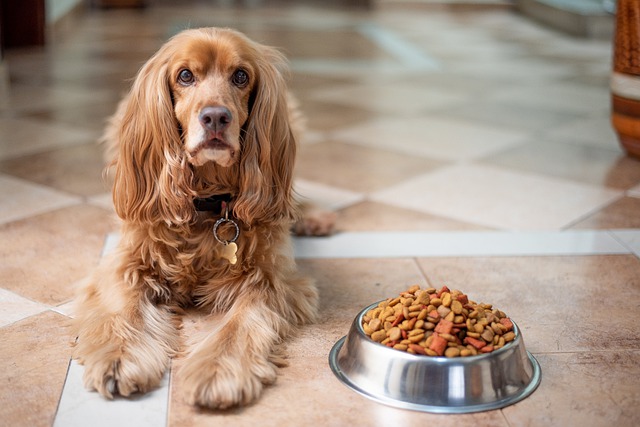
Eating well and having good weight management early on in her life lays the foundation and a head start for your puppy to lead a long and healthy life. It is possibly the cornerstone of your puppy health care!
Tackling obesity is perhaps the most popular topic to dog owners both new and old. The solution however, is straightforward; eat less and exercise more.
While its true obesity leads to all sorts of problems down the road like diabetes, arthritis and hip dysplasia just to name a few. Not enough is being said about being underweight! Underweight dogs are less able to fight off infections, less enthusiastic and just a general lack of energy. That said, being slightly underweight is always preferable to being overweight.
To get a sense of how your dog is doing in the weight department, do this quick review preferably once every 3 to 4 days. Using your hands to feel and eyes to scan, it will only take you less than 2 minutes! This can also be done in conjunction with weekly grooming with a quick routine head-to-tail body examination, saving you time.
· Underweight
Waist and abdominal tuck are very visible. Minimal fat over ribs, mostly just skin. Ribs, spine and hips are easily felt and visible.
· Ideal
Waist visible behind ribs from top view. Abdominal tuck rises just above ribs. Thin layer of fat over ribs and only the online of the last two ribs should be visible. Able to feel the bumps of his rib cage without pressing in. Able to feel the bumps of her two pelvic bones over her rump without pressing in.
· Overweight/Obesity
Waist not prominent from top view. No to little abdominal tuck visible from the side. Excessive fat prevents ribs, spine and hips from being felt.
Get a sense of how well your puppy is growing with this puppy weight chart.
While specifically aim to address large breed puppies diet, there are aspects here that are applicable across all breeds!
Dry puppy food is the cheapest and easiest way to feed your puppy. Find out here what to look out for in a quality choice.
Puppy food allergies and the difference compared to food intolerance.
Puppy not eating is serious as growing puppies cannot afford to skip many meals.
2) Grooming and combining other puppy health care routine
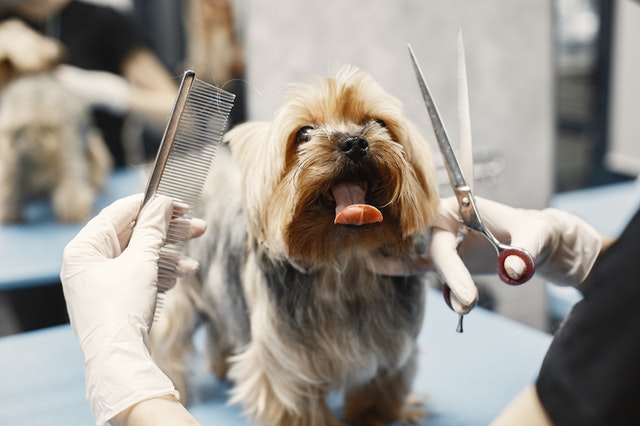
Getting your puppy used to or better yet enjoy the grooming process early in her life is paramount. As such, you'll want every session to be a positive experience. Always be gentle when handling your dog's paws, ear, tail, legs and mouth during grooming and inspections. Puppies' coat and skin are very tender during this stage of their life, so again, be extra gentle.
Regular grooming is an essential part of puppy health care. The benefits are multi-fold. Firstly, it is yet another activity that foster trust and bond naturally through necessity. Secondly (and obviously), it keeps your puppy in good shape. Last but not least, grooming is a great time for routine head-to-tail examinations like the puppy weight review mentioned earlier. You can even throw in a full body massage (which your puppy will love) for a full-wellness suite!
With familiarity, both in the way you go about the grooming process and your puppy's growing cooperation, you can only get more efficient!
Puppy grooming are categorized into 6 areas. They are:
- Brushing
- Bathing
- Nail trimming
- Oral care
- Ear cleaning
- Cleaning anal glands
To learn how to go about puppy grooming in these 6 areas, click here!
Back to top
3)Annual checkups
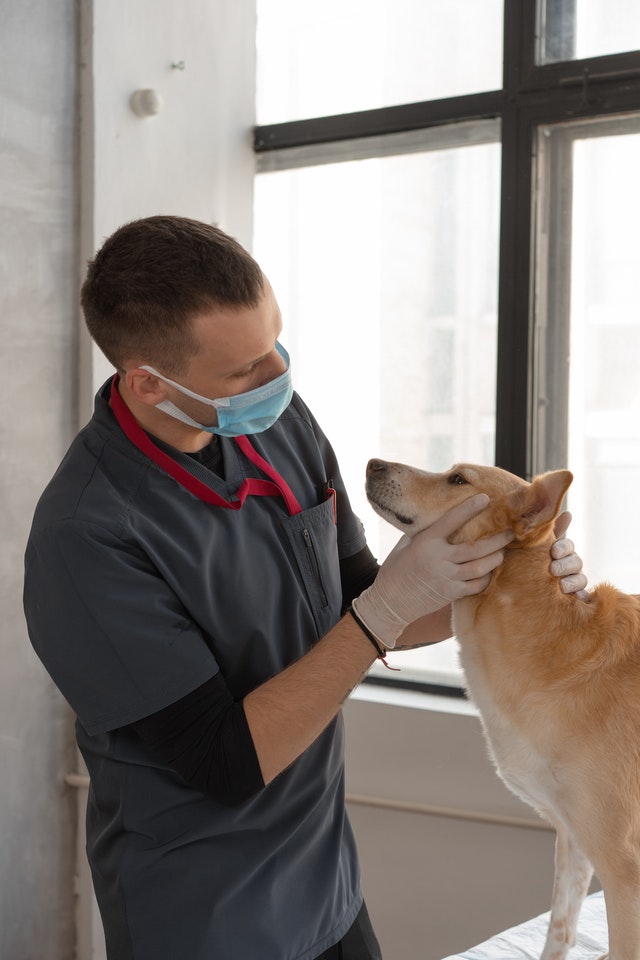 Annual checkups are essential to puppy health care. Don't skip them!
Annual checkups are essential to puppy health care. Don't skip them!Regardless of how you acquired your new puppy, schedule her first health check-up with your vet ideally 4 to 10 days after settling in. Once a record of health has been established, speak with your veterinarian about working out a "maintenance type" puppy health care plan which will include deworming, vaccinations, dental care, spaying(neutering) and more.
A dog needs one or two routine health checkups annually. At the minimum, once a year to ensure no hidden health crisis is brewing under your nose. It is easy to put off regular checkups like these when your dog seem so lively and healthy. Don't! Prevention through early diagnosis will (always) save you more money and heartaches in the long run.
4)Taking up a veterinary insurance
Veterinary emergencies are Expensive affairs ( yes that's expensive with a capital E), it is wise to consider taking up a policy for your puppy even if you think you got spare cash for such occasions. This is especially true when you got multiple dogs or young puppies.
Bear in mind that you still needs to pay your puppy's medical bills upfront and then apply for claim later. However, it is often a huge relief when you manage to claim back most of that surgery fee that cost you thousands of dollars. Suddenly, the premiums that sets you back $60 - $100 monthly seems like pretty good deal! The last thing you want in a emergency is having to worry about both the state of your puppy and your family's expenses for the coming month. And that is perhaps the best incentive of insuring your dog; a peace of mind.
Before you went off to secure a policy, note that insurance typically exclude covering: vaccinations, annual checkups, spaying/neutering, microchipping, flea/tick treatment, heartworm medication and teeth/ear cleaning.
5)Vaccinations - the heart of puppy health care
While some controversy regarding long-term side effects associated with vaccinations have yet to be clearly defined, there is no question that vaccinations are an essential tool when it comes to puppy health care.
Vaccines are divided into two groups, the core and noncore vaccines. Core vaccines are a must for all puppies as they protect against the four diseases that are highly contagious with a body count. These terrible four are:
- Parvovirus-2 - This deadly viral infection affects the lining of a puppy's intestinal wall. Symptoms include vomiting, severe diarrhea, and depression.
- Distemper - A tricky to diagnose respiratory disease. Early symptoms include fever and loss of appetite. Then infected puppy appears to recover after a couple of days as the disease incubates for the next six to nine days. More severe symptoms after the incubation phase include eye and nose discharge, vomiting, diarrhea, lost of balance, brain swelling and seizures.
- Canine hepatitis - Transmitted mainly through stool and urine. This deadly disease could cause respiratory tract illness. Symptoms include fever, constant coughing and an enlarged liver.
- Rabies - Perhaps the most horrid of the four, Rabies transmit through saliva and bite wounds inflicted by infected animals. The disease incubates for a month or two in the brain before symptoms are revealed which include disorientation, fever, aggression (with biting tendencies) and seizures. In its final stage, the infected dog becomes paralysis, froths at the mouth and dies a slow, painful death no dog deserves. This disease is the closest thing to a real-life zombie flick with non of the fun. But the good news is you can prevent it by vaccinating your puppy!
Noncore vaccines on the other hand are usually recommended based on your puppy's "lifestyle risk" or geographical location. For example, a Lyme vaccination is more important in areas where there are recent outbreaks of the disease. Or perhaps your puppy frequent dog parks where she is constantly expose to other dogs in which your vet might suggest a course against the Kennel Cough.
Most noncore vaccines related diseases are rarely fatal. But some of them might take weeks to recover not to mention the possibility of them developing into complications if not treated properly. Remember, your vet will always know best about the current situation in your area and advise you accordingly.
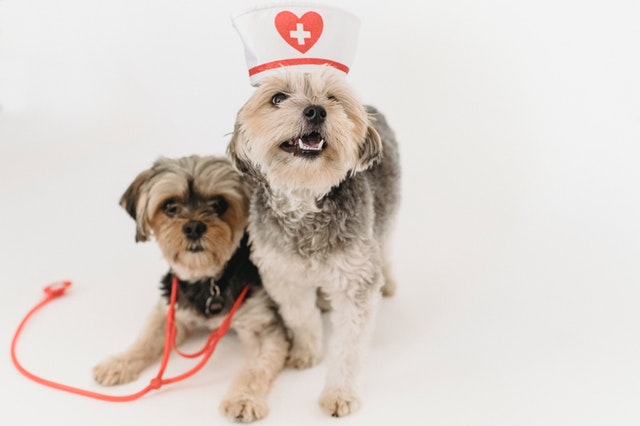
6)Deworming
Deworming is the process of preventing or removing parasites latched onto your dog. Because dogs sniff, lick and trek everywhere, parasites will find their way in at one point or another. It is inevitable. Left unchecked, parasites can cause great discomfort to your dog, impacting her quality of life at best and at worst, develop into other major health issues.
From fungus, bugs to actual worms, parasites come in many forms and sizes but are generally divided into two categories: external parasites and internal parasites.
External parasites are found within a dog's coat or on the skin including the ear canal. This group is compose of the ineptly named Ringworms (which are not actually worms but a type of fungus) and "classics" such as the fleas, ticks and mites.
Today, there are lots of over-the-counter products such as shampoos, spray or powders that can treat these parasites with varying degree of safety and result. Some of these products may be toxic or causes skin irritation to your puppy so read the labels and follow the directions carefully! When in doubt, snap a picture of the label or find the product description online and consult your vet before you invest or better yet, ask your vet for a recommendation.
When you find a parasite, chances are there are more hidden somewhere around your home or on your dog herself. The keyword here is "Prevention" and preventing infestations is unfortunately, a lifelong battle.
In your home, regularly clean everything your puppy frequent. For example; a weekly wash of her bed, your own bed linens (if she sleeps with you) and her toys. Mop the floors and vacuumed the carpets, sofa and your car seats every couple of days. If you have a garden or a lawn, remove dense weeds and trim the grass as these microenvironments are often favorable for ticks and fleas to thrive.
When your puppy is out and about, try to keep her away from wild animals such as strays, monkeys or wild birds (including ducks and swans) just to name a few as not only are they likely carriers of external parasites, they are likely vectors of diseases as well.
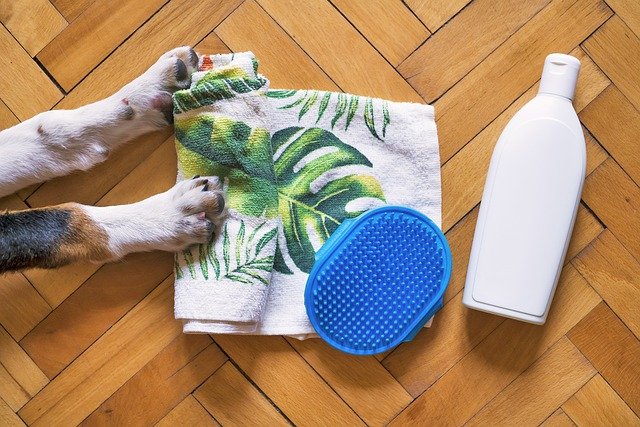 Parasite busting plays an important part in puppy health care by preventing other serious health ailments. Parasite busting plays an important part in puppy health care by preventing other serious health ailments. |
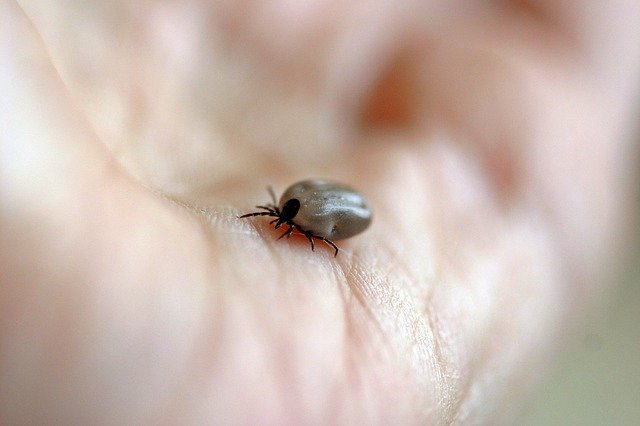 Close-up of a tick. Close-up of a tick. |
Internal parasites pose more of a health hazard compare to their external counterpart. As the name implies, internal parasites live within dogs found mostly but not limited in the gastrointestinal tract. Majority of these parasites thrive by hoarding nutrients, causing malnutrition, stalling development and compromising the immune system. This makes them especially dangerous to puppies.
Internal parasites are usually spread through insect bites(usually mosquitoes and external parasites), contaminated food/water and stepping on or eating of another animal's feces(yuck!).
Heartworms, tapeworms, whipworms, hookworms and roundworms are some of the most common parasites although they are far from the only ones. Today, there are a variety of off-the-counter medications for deworming and just like the case of external parasites, these medications differ in safety and results. Read the labels carefully and consult your veterinary before administration!
The most reliable way to prevent internal parasites beside stopping your puppy from eating poop, is to leave it to the professionals(aka your vet). Have your puppy dewormed by your vet for roundworms and tapeworms every six months. If you suspect your puppy is under attacked by these pests, consult your vet for a diagnosis and an accurate treatment.
Phew! That seems like a lot of work! Parasite busting is a tedious aspect in puppy health care. But think of it this way; parasites affect not just dogs but humans as well. Whether you have a dog or not does not change the fact that these pests have adverse effects on our well-being and are always hidden around us. Having a dog simply raise our awareness about them and that's never a bad thing.
7)Neutering or spaying
Contrary to some beliefs, spaying or neutering dogs is not cruel, quite the opposite in fact. The procedure will not make them fat. Nor will it alter their personalities. Some people mistook the lack of hormonal drive behaviors after the process as being less enthusiastic but the truth is unless you intend to breed your dog, hormonal drives usually leads to problematic behaviors and safety issues.
With that out of the way, here are key reasons why spaying/neutering is such an essential part of puppy health care:
- Male dogs tend to be less dominant and territorial(aka aggressive) after procedure. They are less likely to mark your home or get into fights with other males. Neutering also keep males from escaping homes or running off in the park to find mates.
- Spaying prevents female dogs from going into heat and menstruation. Medium to large dogs typically menstrual twice a year while smaller breeds cycles about three to four times per year. Menstrual bleeding last for three straight weeks at a time and it is as messy as you imagine.
- Spaying or neutering helps prevent breast, uterine, ovarian and cervical cancer in females. For males, it reduce the chances of testicular cancer and prostate infection.
- Gastropexy is a surgical procedure that can be done together with spaying/neutering upon request. This process pins the stomach to the abdominal wall to prevent a separate but serious condition known as Bloat which fills the stomach with gas and twists it (ouch!).
- A female dog can birth a litter of 5 - 6 puppies on average. If these puppies are strays or unplanned, they will likely go on to produce more strays or be abandoned. Every year, millions of dogs are euthanized in animal shelters and many more suffered as strays. Spaying/neutering your puppy is about doing your part in preventing overpopulation. It is about preventing needless suffering and deaths among the dog community.
8)Day-to-day puppy health care
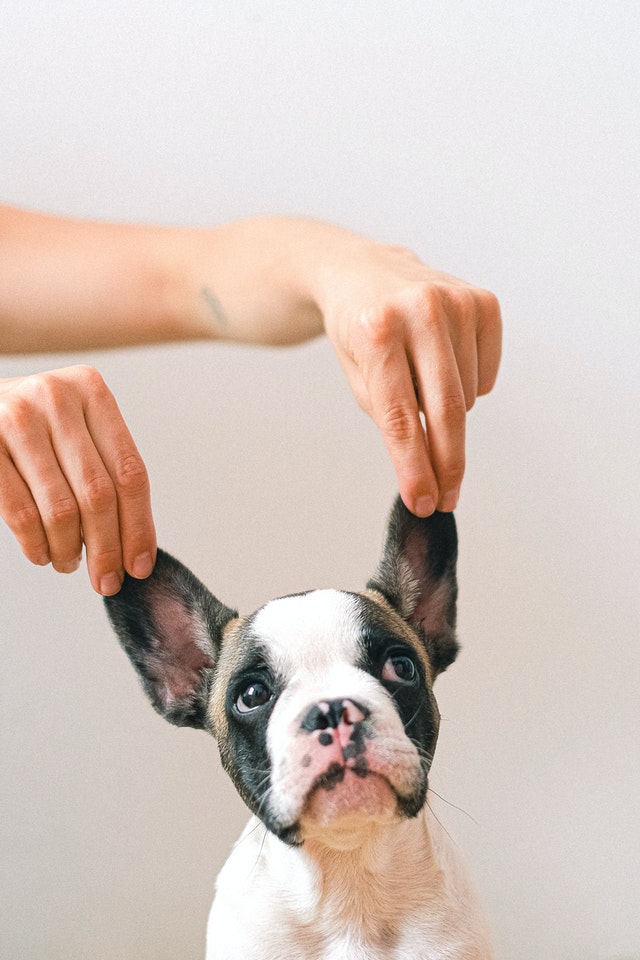 Check and clean those ears regularly!
Check and clean those ears regularly!Dogs can't tell us directly when they feel under the weather. Sure, limping and shivering are obvious signs that something is wrong but there are myriad of ailments and illness that are a lot more subtle but just as concerning.
Fortunately, by being just a little more sensitive (which will be second nature to you quickly), you will be able to pick up hints from your dog with relative ease. Now, being able to read the signs simply means knowing when to see a vet. It is not the same as attempting to play doctor yourself or just wait it out and hope for the best. The rule of thumb is; regardless whether you are sure or unsure what is wrong with her, always check with your vet. Always. Even if it is just a phone call.
With that said, trust your gut! If you think she needs help, then get help. No one knows your dog better than you.
Now, to get you started on what to look out for:
- Lethargy - Dogs, particularly puppies are easily stimulated. A general lack of interest in everything otherwise is a cause of worry especially if it is accompanied by loss of appetite.
- Persistent scratching - Indicate the likely presence of parasites such as mites, fleas or ticks. Check her coat, skin and ears for these pests.
- Rear irritation - If your dog constantly bits and lick her rear end, it may be a sign of worm infestation. Dragging her bottom along the floor on the other hand is a symptom of anal-sac irritation.
- Loss of appetite - If your dog refuse to eat even her favorite food for more than 24 hours, consult your vet immediately. For young puppies, forward your concern by the 12 hour mark.
- Urinary tract issues - Changes in urinating frequency and the amount of urine, whether she now suddenly produce only a few drops at a time or in unusually large amount.
- Behavior changes - A change in behavior towards aggression is a sign of distress and pain. If you notice your usually happy and docile dog seems to snap or growl more often, you guess it, a visit to the vet is in order.
- Joint pains - Common in older and bigger dogs but a bigger concern in otherwise healthy puppies. The causes are many, from play accidents you might not be aware of to joint diseases. Symptoms include but not limited to, limping, weakness, stiffness, favoring a leg, difficulty in climbing and the lack of desire to jump or run.
- Eyes - Inflamed cornea, watery eyes (no, not the cute, begging type), discharge, swelling and cloudiness are some symptoms of eye infections or corneal injuries.
- Ears - Symptoms of ear infections are head shaking, profuse ear scratching, dark brown wax, bleeding, swelling, unpleasant odor, discharge and loss of balance.
- Digestive disorder - Some common ailments are intestinal obstruction, food poisoning and anal-sac irritation. Signs include, increased defecation in frequency, distress while urinating or defecating, weight loss, diarrhea, vomiting, constant regurgitation, reduced appetite and constipation.
- Coughing or sneezing - Might simply be a one-off allergic reaction. Constant coughing or sneezing however could be a sign of more serious respiratory problems like ingestion of toxic substances, object stuck in the nose or the Kennel cough disease. Other indicators are wheezing, loud breathing, rapid shallow breaths, gagging and struggling to breath.
- Increased thirst - Although rare in puppies, increased thirst in dogs may indicate hormonal disorder such as Cushing or diabetes.
9)Exercising for fun, fitness and good habits
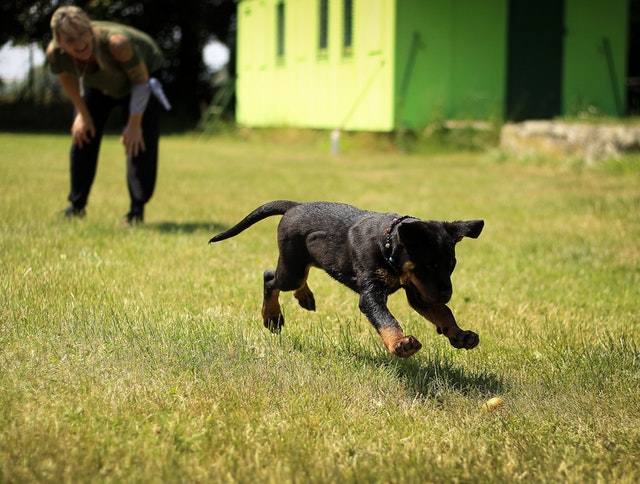
Aside from the obvious burning of calories and keeping her fit, exercising and playing games also promote blood circulation, maintain flexibility, building strength for growing puppies and aging dogs alike, aids digestion, strengthens respiratory system and many more.
And those are just the physical health benefits of daily work-outs! Mentally, exercising and playing games are the best ways to bond with your dog. It stimulates her mind, keeping her sharp while staving off boredom and depression. Its good to point out here that many unwanted behaviors such as barking, teething and home ransacking stem from boredom and depression.
Last but not least, playing and exercising is a great time to instill good habits. Take for example, playing a game of Chase or Hide and Seek. Puppies love to play Chase but in this case you don't take turns being the catcher, your puppy should always be the catcher and encourage to come after you, not the other way around. In the real world, this teaches her to be more aware of your location and to always seek you out instead of running away from you, possibly endangering herself.
Go to Puppy Sneezing or Coughing
- Home
- Puppy Health Care